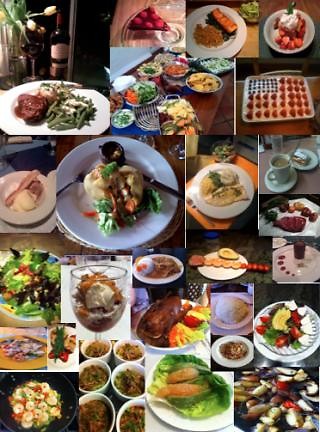Richard Roane wasn’t an artist when he decided he wanted to somehow participate in ArtPrize; he was a lawyer with a love of art. But after a year of working on his entry, “I think I am [an artist] now,” he says with a smile.
His art shows that without the need for extra words. His collage, containing 403 pictures having anything and everything to do with food, could captivate a viewer for hours, picking out every minute detail. It’s a huge project that took massive amounts of time to complete (think three hours every night for a year), but it was worth it, he says.
His love for art started in the 11th grade, when he took a class on art history and appreciation. That spark was rekindled when he graduated law school and began collecting art. One of his first moves when he moved to Grand Rapids was to buy a piece of art from a local artist. “When I travel, I always look at art,” he says.
Despite his love for art, Roane never thought he’d do something like ArtPrize. “I never thought of myself as an artist,” he says. While his family is very artistic—his mother has an art degree, and his brother is a home designer—his creative interests always lay elsewhere, in food. “It’s artistic in a temporary way,” he says about the “art” of cooking.
He started cooking when he was eight years old, when his single mother split up the chores between the six children in the family. He started small—making lunch for his brothers and sisters, or a pancake breakfast for the family Christmas morning—but his cooking soon escalated to the point where he ran a catering business in Los Angeles while he was attending law school.
His passion for food has not been depleted by his job as a full-time lawyer. He still cooks for himself six nights a week, and takes cooking classes to improve his skills. Once, on a trip to Italy, he even learned how to make homemade pasta. One of his favorite things to make, especially in the winter, is soup. He often makes several pots, cooking by feel rather than with a recipe, and he gives much of it away to family and friends. “I like to, I guess, sometimes experiment with flavors,” he says.
It makes sense, then, that when he decided to participate in ArtPrize, the first thing he did was go home and take a picture of his dinner that night. He took pictures of food every day from there on out—meals he made himself, those he ordered in restaurants, cakes, pies—though he had no idea what he was going to do with them until mid-February, when he decided to create a collage. By August, he had over 1200 images, still with no clear idea of how he was going to put them together. He began by putting the photos through the editing and printing process, mounting them on 23 different photo boards which were then mounted on a black 4x8 sheet of plywood. The result? A collage of food—being prepared, on plates, with the cooks who made them—containing 403 mouth watering images that you could spend all day sampling. The most common comment he hears from viewers? “This one makes me hungry.”
As an ArtPrize artist this year, instead of just a viewer, it’s “more exciting,” Richard says. “It’s exciting to see people’s reactions to my creation and I like to share it with them.” Richard wasn’t out to make the most perfect piece of art, or the most beautiful. In his words, “I wasn’t trying to win any prizes. I just wanted to participate; I wanted to be a part of it.”
As an art lover and, now an artist himself, Richard has very distinct opinions of what kind of art he likes: “Something that makes me feel good. Something that’s got beauty in the image, whether it’s abstract or finite.” He admits that what makes good art isn’t always easy to define, though. “I guess it’s a very personal question,” he adds.
His methods of critiquing art are equally personal and subjective. He looks at “what is the image, what does it feel like” and “the message, if there is one.” He knows that there’s really no way to define what makes “good” art. What a person likes is very subjective and, often, very personal. On his own methods of selecting art to buy, he says he will choose it “if it’s got an image that speaks to me.”
When this conversation circles back to ArtPrize, his excitement for this event shows on his face. “It’s important to look at art, maybe something you wouldn’t really look at,” he says. ArtPrize is great, he says, because, “Everything’s accessible, everything’s out there,” available to the masses for art education and appreciation. Everyone can find something that they can learn from, that they enjoy at ArtPrize.
He ends with “I guess my message would be, find what you like.”
The Rapidian, a program of the 501(c)3 nonprofit Community Media Center, relies on the community’s support to help cover the cost of training reporters and publishing content.
We need your help.
If each of our readers and content creators who values this community platform help support its creation and maintenance, The Rapidian can continue to educate and facilitate a conversation around issues for years to come.
Please support The Rapidian and make a contribution today.


